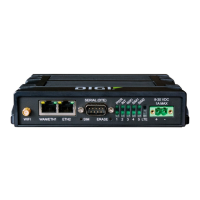Routing Virtual Router Redundancy Protocol (VRRP)
IX20 User Guide
463
3. Create a new VRRPinstance, or edit an existing one. See Configure VRRP for information about
creating a new VRRPinstance.
4. Enable VRRP+:
(config)> network vrrp VRRP_test vrrp_plus enable true
(config)>
5. Add interfaces to monitor. Generally, thiswill be a cellular or WAN interface.
a. Use the ?to determine available interfaces:
(config)> network vrrp test interface ?
Interface: The network interface.
Format:
/network/interface/defaultip
/network/interface/defaultlinklocal
/network/interface/eth1
/network/interface/eth2
/network/interface/loopback
Current value:
(config)> network vrrp test interface
b. Set the interface, for example:
(config)> add network vrrp VRRP_test vrrp_plus monitor_interface end
/network/interface/modem
(config)>
c. (Optional) Repeat for additional interfaces.
6. Set the amount that the device's priority should bedecreased or increased due to SureLink
connectivity failure or success:
(config)> network vrrp VRRP_test vrrp_plus weight value
(config)>
where value is an integer between 1 and 254. The default is 10.
Along with the priority settingsfor devices in this VRRPpool, the amount entered here should
be large enough to automatically demote a master device when SureLink connectivity fails. For
example, if the VRRPmaster device has a priority of 100 and the backup device hasa priority
of 80, then weight should be set to an amount greater than 20 so that if SureLink fails on the
master, it will lower its priority to below 80, and the backup device will assume the master
role.
7. (Optional) For backup devices, enable the ability for the device to monitor the master device.
This allowsa backup VRRPdevice to monitor the master device, and increase its priority when
the master device is failing SureLink tests. This can allow a device functioning as a backup
device to promote itself to master.
(config)> network vrrp VRRP_test vrrp_plus monitor_master true
(config)>

